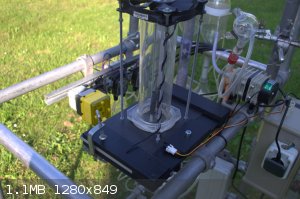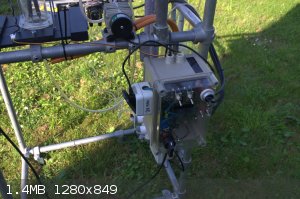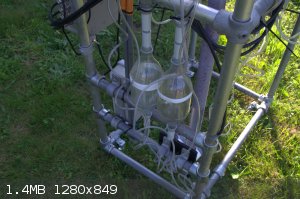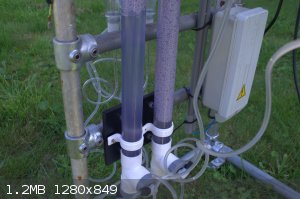| Pages:
1
..
11
12
13 |
Belowzero
Hazard to Others
  
Posts: 173
Registered: 6-5-2020
Location: Member Is Offline
Member Is Offline
|
|
Just wanted to show my nearly completed Pauling furnace.
I've added a couple components such as scrubbing 'towers' which are 1.5m long PVC tubes filled with foamed glass beds.
The total capacity of the 2 columns is roughly 1.5L.
Except for the oxidation chain the device is all PVC and HDPE.
Also currently the system runs with 3 peristaltic pumps (the fourth is still giving some problems)
(Currently the pumps are in series which might not be as effective, still have to do some tests.)
Basically there are 2 pump groups which control the circulation for the towers.
Right now it drips, I will need to create a nozzle of sorts to have the liquid spray, the pumps are quite powerful but not very fast.
The chemical resistance is a major plus though.
Another new feature are the oxidation chambers, there are 2 oxidation chains consisting of 6 coke bottles which are inverted and glued together, this
gives me rougly 6L of volume per chain.
It is very interesting to see the difference in color per chamber showing that it does indeed oxidize! I didn't expect it to be that clear. The second
chain only has very faint color, providing me with the evidence that a third is probably not required.
Every plant needs a frame!
After looking at all sorts of solutions I finally settled for scaffold components which is very strong and allows any sort of shape.
Only downside is the weight but overall it looks great imo.
And finally a control box which allows me to switch the components, I left some room to add relais and control the device from a digital controller
such as an Arduino.
Combining this with temperature probes it would allow me to have a dynamic cool-down period.
My old and simple clock switch didn't like switching a NST and died. So this too will have to be done digitally.
I also made a video of the device for those that are interested:
https://www.youtube.com/watch?v=mp_mvHh9ci0




[Edited on 7-9-2021 by Belowzero]
[Edited on 7-9-2021 by Belowzero]
|
|
|
Texium
Administrator
       
Posts: 4546
Registered: 11-1-2014
Location: Salt Lake City
Member Is Offline
Mood: PhD candidate!
|
|
Wow! What a beautiful and professional-looking setup you've made (Coke bottles notwithstanding  ). Looking forward to seeing what kind of output you end up getting once everything is optimized. ). Looking forward to seeing what kind of output you end up getting once everything is optimized.
|
|
|
macckone
International Hazard
    
Posts: 2160
Registered: 1-3-2013
Location: Over a mile high
Member Is Offline
Mood: Electrical
|
|
Looks very professional.
For a home system, the biggest thing I have found is cooling the absorption unit below 21C to liquify the NO2.
Liquid NO2 with air flow quickly absorbs to nitric acid.
Residence time for NO to oxidize to NO2 is the other big one.
I use a 1L mixing chamber before the absorber and an aquarium pump bubbler.
I need to post some pics.
One thing to note is that NO2 is colored but NO is not, so clear may mean you are getting a lot of NO escaping.
|
|
|
Belowzero
Hazard to Others
  
Posts: 173
Registered: 6-5-2020
Location: Member Is Offline
Member Is Offline
|
|
Quote: Originally posted by Texium  | Wow! What a beautiful and professional-looking setup you've made (Coke bottles notwithstanding  ). Looking forward to seeing what kind of output you end up getting once everything is optimized. ). Looking forward to seeing what kind of output you end up getting once everything is optimized.
|
Thanks Texium.
I was indeed wondering how long the coke bottles would last..
The reason I chose PVC for the scrubbers is that according to compatibility charts it can withstand 30% nitric acid for extended periods/permanent.
This is a similar strength to the maximum concentration obtainable via this method.
I can imagine NOx being quite a bit more aggressive, hopefully the inner layer will react to some extend to become "inert".
Quote: Originally posted by macckone  | Looks very professional.
For a home system, the biggest thing I have found is cooling the absorption unit below 21C to liquify the NO2.
Liquid NO2 with air flow quickly absorbs to nitric acid.
Residence time for NO to oxidize to NO2 is the other big one.
I use a 1L mixing chamber before the absorber and an aquarium pump bubbler.
I need to post some pics.
One thing to note is that NO2 is colored but NO is not, so clear may mean you are getting a lot of NO escaping. |
Will look into that, interesting option.
Please do share.
[Edited on 8-9-2021 by Belowzero]
|
|
|
Alkoholvergiftung
Hazard to Others
  
Posts: 158
Registered: 12-7-2018
Member Is Offline
|
|
You should bend the jacobsladder like horns of an Ram. It climbs up like in the Frankenstein movies. I ve done it and it build engouh pressure so you
dont need an airpump for the reactor inlet. You hear the "wump, wump , wump". If you have an static burn there is no over pressure and i think you
lose an lot of NO because it stands to long in the arc.
|
|
|
Belowzero
Hazard to Others
  
Posts: 173
Registered: 6-5-2020
Location: Member Is Offline
Member Is Offline
|
|
Quote: Originally posted by Alkoholvergiftung  | | You should bend the jacobsladder like horns of an Ram. It climbs up like in the Frankenstein movies. I ve done it and it build engouh pressure so you
dont need an airpump for the reactor inlet. You hear the "wump, wump , wump". If you have an static burn there is no over pressure and i think you
lose an lot of NO because it stands to long in the arc. |
Well I am going to need airpressure to move the gas through the system however it does not need to flow directly through the flame as it does now and
as Pauling intended it (the collapsing and reestablishing of the arc is what produces the most NOx according to the multiple sources hence 'blowing
out' the arc.)
Could you please explain in more detail what you mean by horns of a ram? I never watched the Frankenstein movies tbh.
There are too many ways of interpreting your description or maybe I am too stupid.
|
|
|
Alkoholvergiftung
Hazard to Others
  
Posts: 158
Registered: 12-7-2018
Member Is Offline
|
|
When you bend the ends of the jacobsladder in an halfcircle so the arc is disruptet if you dont bend it it stands on the top. Ive done it without
bending and the arc moved slowly to the top but if you bend it it rises continuously (and realy fast) and disconnect an the top.The pressure was
enough to bubble the gases throught water if you use an standig arc you need an airpump. oh and i used more than 45degree angle around 65.
|
|
|
Belowzero
Hazard to Others
  
Posts: 173
Registered: 6-5-2020
Location: Member Is Offline
Member Is Offline
|
|
Thanks for clarifying, Ill try bending some copper pipe in such a shape.
Anything thinner just doesnt last, fun for demonstrations not for continuous production.
|
|
|
Alkoholvergiftung
Hazard to Others
  
Posts: 158
Registered: 12-7-2018
Member Is Offline
|
|
Dont know if it helps you but my reactor was an 30mm diameter test tube and i made an hole in the bottom with an small gasburner so the gas flow was
from bottom to top. I seald it with two componets glue. Was only test reactor with 50w arc. But it worked. My next try (when i have time) is tu make
an aluminium cooling body like an sleeve over the test tube. Turned from an aluminium roundbar. Haber wrote that if the reaction chamber would be out
of metal the yield would much higher. I have no idea how he wanted to prevent short cuts from the electricity. But the sleeve would my solution.
|
|
|
Texium
|
Thread Moved
19-11-2023 at 09:52 |
akmetal
Harmless

Posts: 42
Registered: 20-11-2023
Member Is Offline
|
|
I have a fully functional reactor but I am working on increasing the efficiency so I can provide feed stock for pure nitric for semi commercial
purposes.
I also have to stop the gas leaks - I am either going to buy an eductor or design one.
|
|
|
Rainwater
National Hazard
   
Posts: 850
Registered: 22-12-2021
Member Is Offline
Mood: indisposition to activity
|
|
https://www.sciencemadness.org/whisper/viewthread.php?tid=15...
here is a 3d models for a simple 'eductor' also know as Venturi valves.
"You can't do that" - challenge accepted
|
|
|
akmetal
Harmless

Posts: 42
Registered: 20-11-2023
Member Is Offline
|
|
I found this cool video - https://www.youtube.com/watch?v=0yK4Mzv7ei0
Its basicly just a venturi with a break in it to exploit the vacuum pressure section where the process gas enteres. I would think that you could just
do a finite element analysis on a venturi for a gas and then find the lowest pressure region and thats where your break is? But then how far do you
pull back the nozzle?
I reached out for a quote from Fox Venturi and am a little concerned the price point is going to have me building my own .....
|
|
|
| Pages:
1
..
11
12
13 |